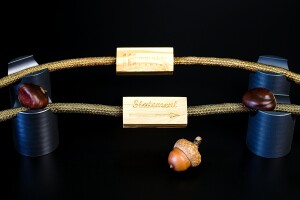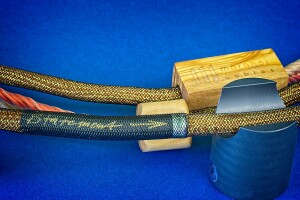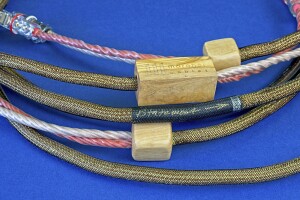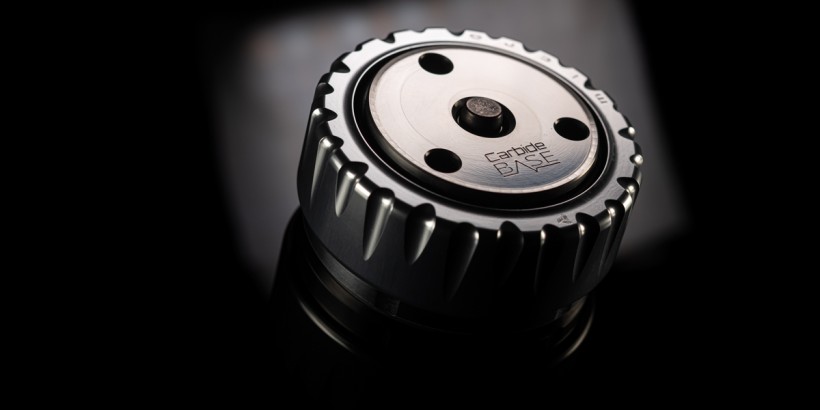Over two years ago I was offered a chance to discover a completely new (to me) brand of audio cables from Croatia, recommended by a trusted friend, the Marohei Cables. I reviewed the back then flagship RCA interconnect Maduro S and Maduro C speaker cable, which have since been replaced at the top of the lineup by the Marohei Statement reviewed this time.
Introduction
Same as before, manufacturer delivered an RCA Analogue IC and Speaker Cable for an assessment. Hence the point was to check what kind of progress Mr. Maro Filičič has managed to achieve over these two years. Since the Maduro cables presented already an impressive performance (see the review HERE) from a new line boldly named Statement I expected quite a lot. It’s never been a secret that I love audio products from small, boutique manufacturers. While I appreciate the fact, that large tycoons due to stronger financial foundations (hence, for example, larger and better founded R&D departments) and years of accumulated knowledge and experience of several engineers have some advantage over smaller competitors, the latter, that are usually one-man-operations (or truly small ones anyway), treat products they develop as these were meant for themselves hence pour their whole hearts and souls into them. I’ve met many such people and they have almost always been truly driven, passionate music lovers, who first and most of all want to achieve the best possible sonic results, so that they could enjoy the music and be proud of their own achievement. Secondly they realize that they back their products with their own names, which was usually the case in the “good old days” of audio industry, that since then became mostly nameless. Such small manufacturers realize therefore that they will be personally held accountable for faulty, low quality products or poor customer service. Such enthusiasts are therefore still result-oriented, but in their case a result means high sound quality and customer satisfaction, and less so a goal in the form of balancing a P&F account (which they have to do as well, if they want to keep their business afloat, but it is not their primary focus). Let me remind you (I mean those, who read the previous review) the statement you will see first after going to Marohei’s website clearly describes what’s truly important for this brand:
I’ve met many such people and they have almost always been truly driven, passionate music lovers, who first and most of all want to achieve the best possible sonic results, so that they could enjoy the music and be proud of their own achievement. Secondly they realize that they back their products with their own names, which was usually the case in the “good old days” of audio industry, that since then became mostly nameless. Such small manufacturers realize therefore that they will be personally held accountable for faulty, low quality products or poor customer service. Such enthusiasts are therefore still result-oriented, but in their case a result means high sound quality and customer satisfaction, and less so a goal in the form of balancing a P&F account (which they have to do as well, if they want to keep their business afloat, but it is not their primary focus). Let me remind you (I mean those, who read the previous review) the statement you will see first after going to Marohei’s website clearly describes what’s truly important for this brand:
„We design and build high performance products which will let you experience music like never before.”
So unless the first question you ask yourself before purchasing an audio product is: what will be its re-sale value, what such small manufacturers have to offer might be a good choice for you, unless we are talking about some hi-tech components, when technological advantage of larger companies may play a role. Why should you at least check out products from small brands? Simply put – in most cases you will get more (in terms of performance, personal touch and so on) for your money. Plus, there is something about such products, something hard to pinpoint, but always there. Namely, as I’ve mentioned before, these are products with soul, with a small piece of heart of a man/women behind them, filled with their passion.
That’s how I remember my first encounter with Marohei cables – brand I’d never even heard about before, had no expectations towards, that surprised me with a nicely made and wonderfully sounding, highly musical and enjoyable cables. Based on that experience I expected even more (particularly in terms of performance) from the new Statement line products as well. These are not cheap cables – the name Statement speaks for itself. Yet, compared to top models of bigger brands, the pricing seems attractive, assuming they actually do offer top performance. Let’s check.
Design
As all Marohei cables, also the ones from Statement line are made by hand. As the manufacturer explains:
„All our products are handmade, because we deeply believe that human hand is a perfect instrument and there is no better way to produce high quality product that you would like to live with, a long and happy life!”
And then:
“About 90% of built in elements in a single cable is of our own production. We are one of not many companies which in dielectric technology uses the best capillary silk, as well as our own electrolytic purification and deep cryo system.”
For the Maduro Statement RCA Interconnect as a conductor manufacturer decided to use TMT high purity multicore soft unneald long crystal 19AWG silver. As already mentioned the material of choice for dielectric is Mulberry silk, used as braided multilayer tubing. As for the RF and MF shielding Marohei in this model uses high quality low resistance tinned copper expandable braid and P.T.F.E. hydro protection. As an outer slayer they utilize an expandable single core braided sleeve over golden, polished cotton one. The interconnect is terminated with high quality WBT 0102 ag RCA plugs. For their top series Marohei uses elements made of solid Croatian olive wood for controlled dissipation of vibration.
The Statement speaker cable on the other hand features solid core TMT high purity soft unneald long crystal AWG 12 silver and copper conductors. The same Mulberry silk tubing is again used as dielectric, but this time every solid core conductor is individually insulated, and on top of that a P.T.F.E. hydro protection is applied. Cables are finished with expandable single core braided sleeving over golden, polished cotton tubing. Statement speaker cable can be order with either WBT 0661cu /0681cu banana or spade connectors. Again elements made of solid olive wood are used for controlled dissipation of vibration. Marohei cables may not look as fancy as some other top products from industry’s tycoons, but they offer a truly nice feel of dealing with natural, user-friendly materials. Plus they are hand-made which adds this special „vibe”, uniqueness to each unit. Importantly, both cables are quite flexible and not particularly heavy, so links in your components and speakers are safe.
Sound
Unlike the last time for this test I got a set from one, top series, meaningfully called Statement. While, as explained many times before, I prefer to assess whole sets from one manufacturer hoping for a synergistic effect, even when I get one for a review, I most often start with either IC or SC (usually it’s IC) to only add the second later to the mix. So I started my evaluation listening to the Marohei Statement interconnect and comparing it to my personal reference Hijiri Million KIWAMI and, reviewed at the same time, TelluriumQ Statement (both also in RCA versions), and only later added the speaker cable to the mix. Same as with previous Marohei review I used a simplistic setup – the top of the line LampizatOr Pacific (that replaced Golden Atlantic since the Maduro S +C test) as a source, GrandiNote Shinai Class A integrated amplifier, plus interchangeably GrandiNote MACH4 and Ubiq Audio Model One Duelund Edition loudspeakers. It is worth noting, that the other interconnects and also my everyday speaker cables from LessLoss, feature copper conductors.
The two interconnects, I compared Marohei Statement to, represent top level performance while sounding very, very different from each other. The Kiwami is an amazingly smooth, fluid, rich, bit warm sounding cable, while TelluriumQ is a very pure, transparent, dynamic, detailed, revealing, open sounding beast. One might call them opposites, but the fact is that they do share fantastic resolution and despite different means they both achieve high level of performance and they both are very musical, expressive and highly enjoyable species. The Japanese cable is the one that encourages listeners to just relax, let themselves immerse in the flow of music, truly feel the emotions it carries. It is (in my opinion, obviously) one of the best interconnects particularly when it comes to live vocal and acoustic recordings.
The English IC, on the other hand, seems to strongly suggest listeners using an opportunity it presents to dive deeper into the mix, to study even tiniest details and subtleties, to make a full use of the abundance of the latter, to particularly enjoy highly dynamic, energetic tracks. Kiwami to some (also depending on a system) may sound a bit dark, laid back, while TelluriumQ Statement may appear slightly brighter, more forward, more lively. Neither the former is truly dark nor the latter bright, but that’s how, particularly in a head-to-head comparison, they may be perceived. It should be easy, depending on a setup and individual preferences, to choose one or the other.
Sorry the long, seemingly unrelated to the subject of this review, introduction, but I needed to give some contexts to those of you, who don’t know these two fantastic interconnects used for comparison with the Marohei Statement. Now let’s get to the first of the actual subjects of this review. The Marohei Statement RCA IC turned out to offer, from the very first moment, first of all sort of a seductive, refined, smooth and highly enjoyable performance. I am not even sure whether this interconnect (or speaker cable for that matter) was fully broken in, but I couldn’t detect any usual hints suggesting otherwise. It did perform as it was at its best, from the very first, till the very last day it spent in my system without reaching any particular improvement over time.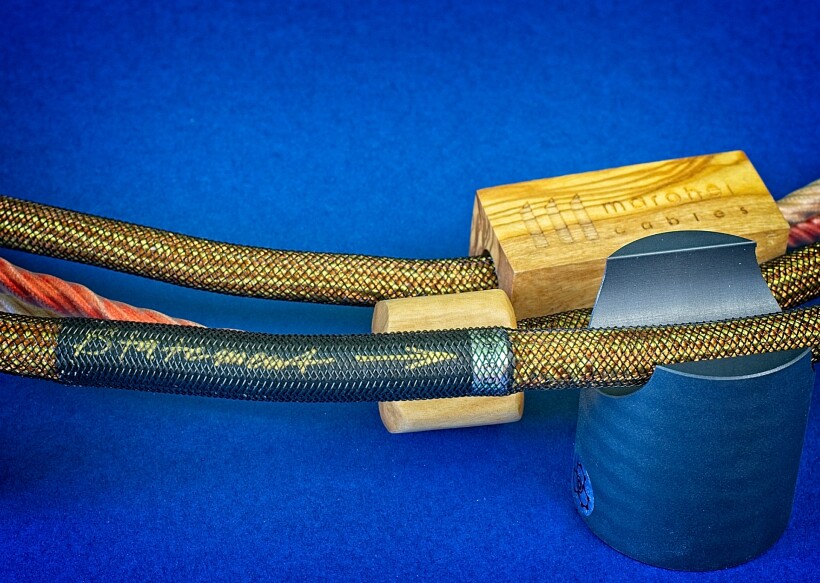
I still meet some audiophiles who claim that silver (meaning cables featuring silver conductors) always sounds bright, harsh, that it lacks richness and natural warmth. The Marohei Statement IC is a perfect example proving that such a stereotype couldn’t be further from the truth. Like all high class silver cables I know, it combines richness, smoothness, and expressiveness of the midrange with beautifully sparking, lively, vibrant, crisp, but never harsh, grainy or (too) bright treble. Sure, some copper cables, say the Kiwami, offer warmer, even more saturated, denser midrange. Still, what the Croatian cable (and the aforementioned top TelluriumQ one) proposes, while it may not be the most beautiful version of midrange focused tracks, it is actually bit more neutral, more true or accurate in most cases. Not always mind you, as when it comes to vocals the Hijiri interconnect, in my ears, conveys timbre and texture of human voice, as well as the emotional layer in the most convincing, most realistic way, with Marohei closely, but not quite at the same level, following in its footsteps in this regard, while being a small step ahead of the TelluriumQ.
In the lower part of the range, the tested interconnect sounded more like the other, TelluriumQ, Statement, than Hijiri. The bass was tighter, faster, cleaner with it (not that it wasn’t with Kiwami, but with the Marohei it was even more so), although not as saturated and warm as with the Japanese competitor. It worked to Marohei Statement’s benefit particularly in all dynamic, fast tracks, hence often in rock, blues, some electronic and many classical recordings of large orchestras. In terms of a transfer of pure energy of playing, the dynamics, particularly on a macro scale, a momentum of large symphonic performances, the reviewed interconnect did an excellent and highly impressive job. I’d say, even a bit better one than Hijiri, and on the same level as the highly acclaimed TelluriumQ. The so-called PRAT (pace, rhythm & timing) with the Marohei Statement IC, and even more so with a whole set (so including same series speaker cable) was exemplary, on par with the excellent British set. It was „contagious” and „addictive” and it made my feet and palms tap the rhythm most of the time and as a result it was responsible for more than one long session with my favorite blues masters.
Only when it came to acoustic bass, double bass to be specific, Hijiri seemed to have a slight edge due to more intense or bit deeper timbre and tiny little bit longer decay phase supported with a bit more wood. It was a truly tiny difference but while comparing or choosing from the three such a fantastic performers, one has to turn to smallest details to make decisions. In this context Marohei Statement followed Kiwami closely while being just ahead of the TelluriumQ. The latter, while also on the tight, fast side of things, seemed to present the deepest, lowest notes with more slam and accuracy at the same time, and the tested Croatian set followed closely this time being a preferred choice over Hijiri. The Marohei and TQ Statements competed for the title of the snappiest and best differentiating IC and later also IC + SC set, and I couldn’t really tell which one was a winner in this regard – they both did an absolutely delightful job.
Trying to establish that, actually inspired another long listening session, this time with percussion recordings (with my favorites such as Steve Gadd, Adam Czerwiński, The O-Zone Percussion Group and others). Both cable sets reproduced each sound of sticks hitting drums or cymbals, in a very fast, powerful, clean manner, differentiating them perfectly, making following even the fastest fragments not only easy, but also highly enjoyable, even (again!) addictive. It was a real fun „seeing” these guys’ perfect drumming skills while appreciating also a high quality of the recordings which allowed the Marohei Statement cables to convey each performance in a uniquely thrilling, exciting way often keeping me on the edge of my seat and holding my breath not miss a single beat.
Listening to, for example, „Blue saxophones” with two giants, Ben Webster and Coleman Hawkins in lead roles, was not only a very interesting, but also beautifully immersive experience. With the Kiwami instruments sounded amazingly smooth, present, the timbre was very rich, saturated. With TelluriumQ the saxophones seemed to sound a bit brighter, bit more piercing, but still natural. Finally, the Marohei Statement while not as dense, as warm as Kiwami, and not as „piercing” as TelluriumQ, did combine best features from both to a large degree. The instruments were both smooth and bit piercing when needed, rich and natural. The sound was open, precise, offering an abundance of details and subtleties but without being overly analytical. There was a lot of air around instruments and the sound was vibrant, lively and beautifully fluid.
So while not as palpable, as uniquely present as with the Hijiri, or as super-revealing as with the TelluriumQ, the Croatian cable delivered this performance in a masterful way fully worth the two saxophone geniuses. It was an immersive, very „here and now” presentation, relaxed, effortless, yet highly resolving, offering an insight into each individual performance but without pushing them forward, without focusing presentation or listener’s attention solely on them. The Marohei Statement convincingly converted an abundance of information regarding tonality, dynamics, performance of each individual musician into a breathtaking rendition of this unique musical performance.
While playing several similar albums, many of them being live recordings of the biggest jazz and blues stars, the Marohei Statement offered the same unique „feeling” of the music as the Kiwami, a similar natural flow, while convincingly rendering an ambiance of each of those events, yet differentiating them nicely too. With musicians almost present in a room, with music freely floating around and this very realistic, or convincing timbre of each instrument added on top, I listened to the music for several hours without event as much as a hint of fatigue, sometimes extending the sessions until a very late night.
So while, as already stated, in terms of midrange presentation, the Marohei Statement reminded me more of Hijiri, everything that happened in the treble area sounded more like with the TelluriumQ Statement. Cymbals, triangle, other percussion instruments sounded particularly clear and crisp, although at the same time bit more weighted (so more Hijiri style, so to speak) – yet another proof of skillful combination of the best features of both (copper and silver) worlds. The differentiation of the high tones was simply exemplary.
To check Marohei Statement’s qualities more comprehensibly I played a lot of various music genres. Among them was also an electronic music, say Jean Michel Jarre from his „Amazonia”, but also (not so much electronic) Andreas Vollenweider from „Vox”. While the space and imaging on such albums are not really „natural”, placement of various sounds around the room, far beyond what one considers a soundstage, must be properly conveyed to create a proper „natural” (in this case translated to „as sound engineer intended”) impression. And the Marohei Statement did a fantastic job in this regard, both speaker and IC combined even better one that separately. Rich, saturated, gently warm character of these Croatian cables and their ability to deliver even thunderous lowest notes, did the trick for this kind of music.
I guess you’ve probably already read it between the lines – my first thought, confirmed later several times over the course of listening sessions was that sonic-wise, I would place the Marohei Statement somewhere between the Hijiri Million Kiwami and TelluriumQ Statement. In some regards it reminded me of the former – with rich, saturated, smooth midrange, but in many, such as dynamics, clarity, transparency, immediacy of every attack, also the latter. In other words it seemed to combine many of the qualities of both and it did really well. It seemed to me that the designer managed to skillfully combine many best features commonly associated with both, silver and copper conductors, into a smooth, coherent, highly truthful, accurate and enjoyable whole.
As you might have noticed, I added the speaker cable to the mix at some point. It did not change the general character of the sound (compared to what Marohei Statement interconnect had brought to the table), but compared to my LessLoss speaker cable it did add some more clarity and opened sound a bit, plus „amplified” the features I’d recognized in the interconnect. Compared to the TelluriumQ Statement, the Marohei Statement speaker cable saturated the midrange bit more while the former added a bit more slam to the lowest tones. Both turned out to be amazingly resolving, highly detailed cables, although the Marohei put a bit less emphasis on the abundance of details themselves, rather using them to build up a complete, rich musical presentation (which is a feature of Hijiri Kiwami). A set of Marohei Statement analogue signal cables definitely offers a synergy effect compared to using only one of them. I don’t see any reason to separate them – if you reach for this product of the Croatian manufacturer don’t hesitate and try them both together out.
Summary
Using the „Statement” designation for any product means, or at least it should, that the manufacturer has reached what they considers their peak achievement. In this particular case it seems to be true, at least for now as who knows what the future will bring. While I highly enjoyed and appreciated the Maduro S and C cables reviewed over two years ago, the Statement series is just better. Sure, two years passed and some changes introduced to my setup in the meantime don’t make comparison either simple nor 100% reliable, but since my system today offers an even better, more refined performance than it did back then, and I did enjoy listening to the music even more this time with the Marohei new cables set, it is safe to assume, that Statement models do represent even higher level of performance in „audiophile terms”, while being highly musical and enjoyable.
These are truly refined, highly resolving, detailed and yet smooth, coherent and natural, or even organic sounding cables. They seem to combine most of the best features associated with silver and copper conductors and I couldn’t really find any flaws in their performance. Sure, as mentioned before, there were some elements my Hijiri Million Kiwami did better (or I should rather say – I liked even better), and the same goes for the TelluriumQ Statement, but overall these are all remarkable, highly enjoyable cables and I have no doubts that each of them will find its fans. It seems to me though, that the Marohei Statement may be the most versatile among them, by which I mean that those who can’t decide whether they prefer, in this example, Hijiri or TelluriumQ cables (or others of similar sonic characters), may choose Marohei as sort of a „golden mean”. Mind you – in this case it doesn’t mean a compromise, but an equally remarkable, reference level performance with lots of features of the other two skillfully combined into an immersive whole. Long story short – the Marohei Statement cables offer excellent performance and will let you enjoy your favorite music in a very special, immersive and even addictive way.
Prices (when reviewed):
- Marohei Statement IC RCA: 2250 EUR /1 m pair; additional 0,5 m: 800 EUR
- Marohei Statement speaker cable: 4900 EUR /2,5 m pair, additional 0,5 m: 900 EUR
Manufacturer: Marohei Cables
Associated equipment:
- Digital source: a passive, custom server with WIN10, Roon, Fidelizer Pro 7.10, JCAT NET XE and USB Femto cards with FERRUM HYPSOS power supply, KECES P8 (mono) linear power supply for the server, JCAT USB Isolator
- D/A Converter: LampizatOr Pacific +Ideon Audio 3R Master Time (USB signal regenerator)
- Analogue front end: J.Sikora Standard MAX turntable, J.Sikora KV12 tonearm, AirTight PC-3, phonostages: Grandinote Celio mk IV, ESE Lab Nibiru V 5.
- Power amplifiers: GrandiNote Shinai, Art Audio Symphony II (modified)
- Preamplifier: Audia Flight FLS1
- Loudspeakers: GrandiNote MACH4, Ubiq Audio Model ONE Duelund Edition.
- Interconnects: Hijiri Million, Hijiri HCI-20, TelluriumQ Ultra Black, KBL Sound Zodiac XLR, David Laboga Expression Emerald USB, David Laboga Digital Sound Wave Sapphire Ethernet
- Speaker cables: LessLoss Anchorwave
- Power cables: LessLoss DFPC Signature, Gigawatt LC-3
- Power: Gigawatt PF-2 MK2 and Gigawatt PC-3 SE Evo+; a custom power line with Gigawatt LC-Y in-wall cable; Gigawatt G-044 Schuko and Furutech FT-SWS-D (R)
- Racks: Base VI, Rogoz Audio 3RP3/BBS
- Anti-vibration accessories: ROGOZ-AUDIO SMO40 and CPPB16 platforms and ROGOZ AUDIO BW40MKII feet, Franc Accessories Ceramic Disc Slim Feet and Wood Block Platform



